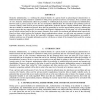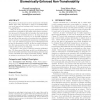ICB
2009
Springer
13 years 10 months ago
2009
Springer
Biometric authentication over public networks leads to a variety of privacy issues that needs to be addressed before it can become popular. The primary concerns are that the biomet...
SSWMC
2004
14 years 1 months ago
2004
Biometric authentication, i.e. verifying the claimed identity of a person based on physiological characteristics or behavioral traits, has the potential to contribute to both priv...
CSREASAM
2006
14 years 1 months ago
2006
- In biometric authentication, feature information of each enrolled person's biometric information is enrolled as templates. Secure databases or anti-tampered devices store th...
BIOSIG
2008
14 years 1 months ago
2008
Abstract: Biometric authentication is often considered to enhance identity verification. The use of biometrics also introduces new challenges to protect the privacy of the subjects...
ICIAR
2010
Springer
14 years 5 months ago
2010
Springer
Two-factor authentication has been introduced in order to enhance security in authentication systems. Different factors have been introduced, which are combined for means of contr...
AVBPA
2003
Springer
14 years 5 months ago
2003
Springer
Abstract. A biometric authentication system operates by acquiring biometric data from a user and comparing it against the template data stored in a database in order to identify a ...
WPES
2003
ACM
14 years 5 months ago
2003
ACM
We present a model and protocol for anonymous credentials. Rather than using deterrents to ensure non-transferability, our model uses secure hardware with biometric authentication...
AVBPA
2005
Springer
14 years 6 months ago
2005
Springer
A novel protocol is proposed to address the problem of user authentication to smartcards using biometric authentication instead of the usual PIN. The protocol emulates expensive Ma...
AUTOID
2005
IEEE
14 years 6 months ago
2005
IEEE
In this paper, we outline a framework for appropriate and proper usage of simulated data for biometric authentication. Currently, there are no formal guidelines concerning the use...
DIM
2006
ACM
14 years 6 months ago
2006
ACM
An emerging approach to the problem of reducing the identity theft is represented by the adoption of biometric authentication systems. Such systems however present however several...




